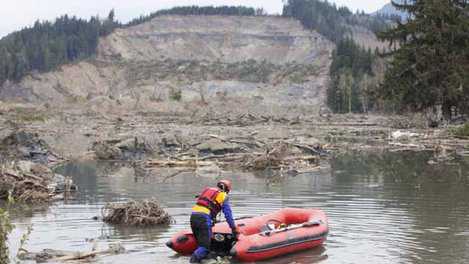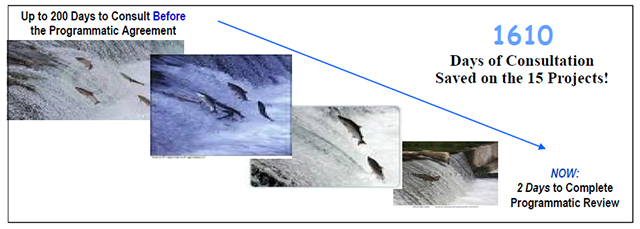U.S. Department of Transportation
Federal Highway Administration
1200 New Jersey Avenue, SE
Washington, DC 20590
202-366-4000
Washington Division
On Saturday, March 22, 2014, a landslide a square mile in size raced downhill at 60 miles per hour, sending massive debris and concrete-thick mud through a neighborhood, across State Route (SR) 530, and into the North Fork of the Stillaguamish River near Oso,WA. Early LiDar images indicated the debris to range from 15 to 75 feet thick. Ultimately, the Oso slide killed 43 people, destroyed more than40 homes, temporarily dammed the river, and cut off the mainaccess to Darrington, Washington, to the east along SR 530. The slide changed the geography and hydrology of the area and the community of Oso forever. |
 |
What We Did
FHWA worked with WSDOT from the beginning. WSDOT, FHWA Washington Division, FHWA Headquarters in Washington, DC, and the U.S. Department of Transportation kept in touch with each other and with local, state, Tribal, and other federal agencies via routine communications – phone calls, texts, e-mails, meetings, site visits – that continued for weeks and months. Conversations evolved from search and rescue, to recovery, to finding detours and debris removal/handling to reopen SR 530.
Within 48 hours of the slide, the FHWA Division requested and USDOT Secretary Foxx released $1 million in "Quick Release" emergency relief (ER) funds for the road. Sensitivity to the disaster that shook the small community of Oso has been paramount. Ultimately, President Obama approved a major disaster declaration for the Oso mudslide and visited the site personally, offering condolences and support to the community of Oso. Debris removal became eligible for Federal Emergency Management Agency (FEMA) aid.
Funds from the FHWA ER program reimburse WSDOT for emergency work done in the immediate aftermath of the mudslide. FHWA will provide additional funds as permanent repairs are identified and cost estimates completed. FHWA's ER program funds the repair or reconstruction of federal-aid roads and bridges damaged by natural disasters or catastrophic events.
Detours
Two SR 530 detours were established – the official one via I-5, SR 20, and SR 530 around the north side, and via Mountain Loop Highway (gravel road with 25 mph speed limit) around the south side, used for emergency and local access only.
WSDOT also established a debris removal contract, and FHWA Division staff helped the state understand the contract requirements. FHWA staff continues to be involved extensively in discussions with WSDOT, FEMA, Washington State Department of Emergency Management (WADEM), the FHWA's Western Federal Lands Highway Division (WFLHD), and local officials on detours, debris removal/handling on SR 530, funding, liabilities, and environmental concerns.
WSDOT identified alternatives for creating a route through the area, including opening the Seattle City Light maintenance road, a one-lane power line gravel road along which pilot cars guide drivers through the route. WSDOT awarded a contract to maintain the roadway and establish traffic control on the Seattle City Light maintenance route, reducing travel time by 90 minutes for those living east of the debris field. Using the two official SR 530 detours. WSDOT sent out a request for qualifications for a design-build contract for the permanent repairs of the SR 530 on April 22,2014. The goal: award the contract in late May, start work in early June, and have all work completed by early October 2014.
Permanent Repairs
Until permanent repairs can be complete, the SR 530 temporary bypass road, known as the "Seattle City Light Access Road" isopen for local drivers, escorted by pilot car. This primitive, single-lane, temporary road with steep grades is open for passengervehicles 24 hours a day. Washington State Patrol and private security staff assist with providing information to drivers and escorting vehicles on the route.
The Stillaguamish Tribe offered its assistance, informing FHWA that the damaged section of SR 530 is onBIA's Tribal Transportation Program Facilities Inventory. This information increased the federal shareof funding for permanent repairs to 100%.
Beginning in mid May, FEMA's debris removal contractor will begin work along clearing the existing SR 530 roadway. The FHWA Washington Division continues to coordinate closely with WSDOT on the detour and permanent repairs.

This chart shows the timeliness of approval for emergency relief (ER) damage inspection reports. Our goal is to approve 90% of these reports within 10 days of receipt. ER reports that exceed 16 days typically are delayed due to external permits and otherfactors. For example, delays in 2014 have been related to Oso Slide Rescue and Recovery efforts.
Approvals
Design Deviations
| Number of Days | 2010 | 2011 | 2012 | 2013 | 2014 |
|---|---|---|---|---|---|
| 0 to 5 Days | 1936 | 1791 | 1655 | 2029 | 1167 |
| 6 to 10 Days | 131 | 41 | 35 | 122 | 97 |
| 11 to 15 Days | 18 | 7 | 1 | 7 | 9 |
| 16 to 20 Days | 3 | 2 | 0 | 0 | 0 |
| 20 + Days | 1 | 0 | 0 | 0 | 0 |
| TOTALS | 2089 | 1841 | 1691 | 2258 | 1273 |
The table above reflects the number of authorizations / modifications approved within certain timeframes since 2007. For FY 2013,our overall approvals within a two-week turnaround was 100%, exceeding our goal of 90%! 5–day FMIS approval turnaround is at 94% for 2013. (FY 2014 is in progress.)

FHWA's quarterly target is to have under 2% inactivity on obligated Federal Funds. The quarterly inactive percentage is found by dividing all projects inactive (no expenditures processed) for 12 months or more by each state's annual apportionments. For Fiscal Year 2014 Washington Division's total annual apportionment is $654,304,963, divided by the un-expended balance $5,246,890.42 of our current obligated Federal Funds gives Washington Division a 0.8% un-expended obligation percentage. This percentage is down from over 3% starting off the year and is the lowest Washington's inactive percentage has ever been!

| For more information contact: | ||
|---|---|---|
| Dan Mathis Division Administrator FHWA Washington Division 360-753-9480 Daniel.Mathis@dot.gov |
Sharleen Bakeman Transportation Specialist - Planning FHWA Washington Division 360-753-9418 Sharleen.Bakeman@dot.gov |
 |